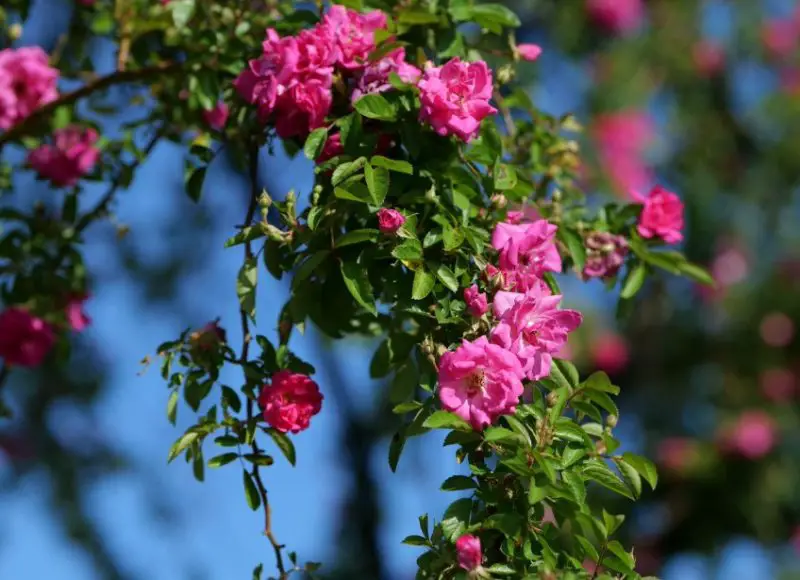The Peggy Martin Rose, often referred to as the “Hurricane Katrina Rose,” is a resilient and captivating climbing rose that has gained immense popularity among gardeners for its strength and beauty.
It earned its name after being discovered by a gardener named Peggy Martin following the devastating Hurricane Katrina. Remarkably, this rose was one of the few plants to survive the storm’s destructive winds and flooding, symbolizing endurance and hope.
In this detailed care and growing guide, we will explore how to cultivate this stunning rose in your garden, ensuring it thrives for years to come.
Overview of the Peggy Martin Climbing Rose

Key Features:
- Hardiness: One of the most intriguing aspects of the Peggy Martin Rose is its ability to survive in various conditions. This rose can withstand hot, humid summers and harsh, cold winters, making it a versatile plant for a wide range of climates.
- Drought Tolerance: Peggy Martin Roses are remarkably drought-tolerant. Once established, they require minimal watering, making them a low-maintenance choice for gardeners.
- Soil Adaptability: These roses can thrive in diverse soil types, from sandy loams to heavy clays. They do best in well-drained soils but are forgiving of less-than-perfect conditions, which contributes to their resilience.
- Disease Resistance: Peggy Martin Roses are known for their exceptional resistance to common rose diseases and pests. This trait reduces the need for chemical treatments, making them a more eco-friendly choice.
- Growth: The plant is a vigorous climber, growing anywhere from 6 to 15 feet in height, with the potential to reach even taller heights when supported by structures such as trellises, fences, and arbors.
- Flowers: The rose features large clusters of delicate, pink, double blooms. These flowers emit a sweet, old-fashioned fragrance and bloom continuously from late spring until the first frost, providing a long season of beauty in the garden.
Propagation of Peggy Martin Climbing Rose
One of the great joys of growing roses is the ability to propagate them, and Peggy Martin Roses are no exception. Here’s a simple step-by-step guide to propagating this rose variety:
Steps for Propagation:
- Select a Cutting: Choose a healthy, 6- to 8-inch-long cutting from the current season’s growth. Make sure the cutting is free from disease or pests.
- Make an Angular Cut: Using clean, sharp pruners, make a cut at a 45-degree angle just below a leaf node. This encourages better root formation.
- Remove Lower Leaves: Strip the lower leaves from the cutting, leaving the top few intact.
- Apply Rooting Hormone: For better success, dip the cut end of the stem into a rooting hormone or cinnamon dust. This will promote faster rooting.
- Prepare Potting Mix: Fill a pot with a well-draining potting mix and make a small hole using a stick or your finger.
- Insert the Cutting: Place the cutting into the hole, firm the soil around it, and water it thoroughly.
- Wait for Rooting: In about 5 to 10 weeks, the cutting should develop roots. Once rooted, you can transplant it into a larger pot or directly into your garden.
By following these steps, you can easily propagate your own Peggy Martin Rose and share it with friends or expand your rose collection.
Requirements for Growing Peggy Martin Climbing Rose
To ensure your Peggy Martin Rose flourishes, it’s important to meet its growing requirements. Below, we’ll discuss the ideal location, soil, watering, and care practices.
Location
Peggy Martin Roses thrive in full sun, which means they need at least six hours of direct sunlight each day. When choosing a location, avoid areas where tall trees or structures may block sunlight. Planting them in a sunny spot ensures vigorous growth and abundant blooms.
Soil
Although Peggy Martin Roses can adapt to various soil types, they prefer well-draining, fertile soil with a slightly acidic pH of 6.0 to 6.5. Before planting, improve your soil by incorporating organic matter such as compost, aged manure, or leaf mold. This not only boosts the soil’s fertility but also improves its drainage and aeration.
To prepare your planting site:
- Loosen the soil to a depth of 12 to 16 inches.
- Mix in organic amendments.
- Ensure good aeration, especially if your soil is compacted, using a garden fork or tiller.
Watering
Proper watering is essential for the health of your Peggy Martin Rose. Water early in the morning or late in the afternoon to reduce evaporation and avoid wetting the leaves, as wet foliage can lead to fungal diseases.
Here’s a simple watering guide:
- In the Growing Season: Water thoroughly, ensuring that the soil around the plant’s base is well-saturated. Allow the soil to dry out slightly between waterings.
- In the Winter: Reduce watering frequency. In mild climates, once a month is usually enough to keep the plant hydrated.
Care and Maintenance of Peggy Martin Climbing Rose
Fertilizing
To encourage healthy growth and vibrant blooms, fertilize your Peggy Martin Rose regularly. Use a balanced liquid fertilizer, such as 10-10-10, every 5 to 6 weeks during the growing season. Dilute the fertilizer to half its strength to avoid over-fertilizing, and always water your plants after feeding to help the nutrients reach the roots.
Stop fertilizing in the fall when the rose’s growth begins to slow down in preparation for winter.
Pruning
Pruning is an essential part of rose care, promoting healthy growth and maintaining an attractive shape. Prune Peggy Martin Roses in late winter or early spring before new growth begins. Here’s how:
- Remove any dead, damaged, or diseased wood.
- Cut back the remaining canes by about one-third of their length.
- Remove any crossing or inward-facing canes to improve air circulation.
Regular pruning helps prevent disease and encourages a more robust flowering display.
Training
As a climbing rose, Peggy Martin can be trained to cover trellises, fences, or arbors. Use soft twine to tie the canes to the support structure, being careful not to tie them too tightly. Spread the canes evenly to create a balanced and visually appealing display.
Pests and Diseases
While Peggy Martin Roses are generally resistant to pests and diseases, they are not entirely immune. Common issues include aphids and spider mites. Keep an eye on your roses and act quickly if you notice signs of infestation.
To treat these pests:
- Use insecticidal soap or horticultural oil.
- For fungal diseases, apply an appropriate fungicide as a preventive measure.
Winter Protection
Although Peggy Martin Roses are hardy down to USDA Zone 5, they may need extra protection in colder regions. After the first frost, mound soil or mulch around the base of the plant to insulate the roots. You can also cover the canes with burlap or frost cloth to shield them from freezing temperatures.
The Symbolism and Legacy of the Peggy Martin Rose
The story of the Peggy Martin Rose is a testament to resilience and hope. After surviving one of the most destructive hurricanes in US history, this rose has become a symbol of strength and endurance. Peggy Martin herself propagated and shared the rose with other gardeners, contributing to its widespread popularity.
Today, this rose continues to inspire gardeners worldwide, not only for its beauty but also for the story it carries.
Conclusion
The Peggy Martin Climbing Rose is a remarkable addition to any garden, admired for its hardiness, low maintenance, and continuous blooms. Whether you are an experienced gardener or a beginner, this resilient plant is easy to grow and offers an abundance of beauty throughout the growing season. With proper care and attention to its basic requirements, you can enjoy the lovely pink blossoms and sweet fragrance of the Peggy Martin Rose for your garden.






